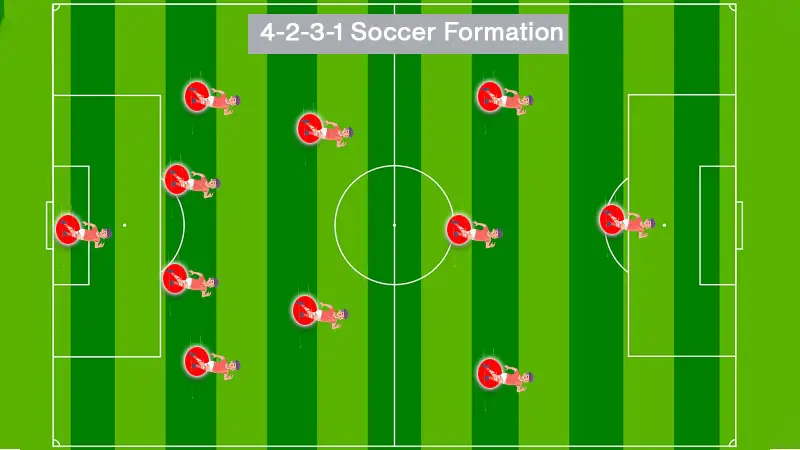The 4-2-3-1 soccer formation has become a favorite among coaches and teams worldwide, thanks to its balance of defense and attack. This versatile setup allows teams to adapt quickly to different game situations, making it a go-to strategy for both professional and amateur squads.
By positioning four defenders, two holding midfielders, three attacking midfielders, and a lone striker, the formation offers a solid defensive foundation while maintaining offensive flexibility.
Understanding the intricacies of the 4-2-3-1 can give teams a strategic edge. The dual holding midfielders provide essential coverage, enabling the attacking trio to exploit spaces and create scoring opportunities.
This formation’s adaptability and balance make it a powerful tool in any coach’s arsenal, capable of shifting the momentum of a match with the right tactical adjustments.
Exploring the 4-2-3-1 Soccer Formation
The 4-2-3-1 soccer formation has gained traction due to its strategic versatility. This section delves deeper into its historical origins and the specific roles of each position on the field.
Historical Origins and Evolution
The 4-2-3-1 formation emerged in late 20th-century European soccer. Initially inspired by the need to counter aggressive 4-4-2 formations, it evolved as managers sought balance between defense and attack.
Managers like José Mourinho popularized this formation by utilizing it successfully in European competitions.
- Goalkeeper: Protects the goal, organizes the defense.
- Center Backs: Provides stability in defense, marks opposition attackers, begins building up play from the back.
- Full Backs: Supports both defense and attack, overlaps with wingers, delivers crosses into the box.
- Holding Midfielders: Shields the defense, intercepts passes, transitions play from defense to attack.
- Attacking Midfielders: Creates scoring opportunities, supports the lone striker, presses opponent defenses.
- Winger Midfielders (Left and Right): Stretches the field, delivers crosses, cuts inside to shoot or create chances.
- Striker: Main goal scorer, holds up the ball, connects play with attacking midfielders.
Tactical Versatility
The 4-2-3-1 formation offers several tactical advantages:
- Defensive Stability: With two holding midfielders and four defenders, it provides a solid defensive base against counter-attacks and opponent pressure.
- Attacking Flexibility: The three attacking midfielders and lone striker create multiple passing options and attacking combinations, making it effective in possession-based play and quick transitions.
- Adaptability: Managers can adjust player roles within the formation based on the strengths and weaknesses of the opposition, allowing for strategic flexibility during matches.
Offensive Strategies in the 4-2-3-1 Formation
Teams use the 4-2-3-1 formation to maximize offensive potential while maintaining defensive solidity. This system supports various attacking strategies that can overwhelm opponents by leveraging specific roles and movements.
Building Up Play from the Back
In the 4-2-3-1 formation, teams build up play from the back to maintain possession and control the game’s tempo. The center-backs spread wide, and the full-backs push forward to create passing lanes.
The two central midfielders drop deep to receive the ball, acting as pivots to transition from defense to attack. Using short, quick passes, they connect with the attacking midfielders and wingers, creating seamless transition phases.
Example: Teams like Manchester City utilize this build-up strategy to dictate play from the back.
Creating Opportunities through the Wings
The 4-2-3-1 formation employs wingers to stretch the opposition’s defense and create scoring opportunities. Wingers hug the touchline, providing width and space for the central attacking players.
They interchange positions with the attacking midfielder and full-backs, creating dynamic attacking plays. Crosses, cut-backs, and one-on-one dribbles are common methods wingers use to penetrate the opposition’s defense.
Example: Bayern Munich effectively uses wingers like Kingsley Coman to exploit spaces and deliver crucial assists.
Defensive Tactics with the 4-2-3-1 Setup
The 4-2-3-1 formation excels in defensive organization, making it a robust structure against various attacking formations. Coaches leverage this setup to balance defensive solidity and transitional play.
Defensive Solidity and High Press
The 4-2-3-1 formation ensures defensive solidity through its double pivot of central midfielders who shield the back four by intercepting passes and breaking up plays.
Center-backs mark attackers while full-backs handle wide threats, maintaining defensive compactness through zonal play. High pressing is crucial, initiated by the striker and supported by attacking midfielders to win the ball in advanced positions.
Teams like Liverpool utilize this high press to disrupt opponents and force errors, requiring players to maintain high energy levels.
Transitioning from Attack to Defense
The 4-2-3-1 formation enables smooth transitions between attack and defense. When possession is lost, attacking midfielders and wingers swiftly adopt defensive roles to thwart counter-attacks.
The double pivot drops back to create a defensive blockade, slowing the opponent’s progress. Counter-pressing is essential during these transitions to quickly regain possession and minimize counter-attack risks, a method employed by teams like Bayern Munich.
Effective communication and positioning are crucial for this strategy.
Advantages and Disadvantages of the 4-2-3-1
The 4-2-3-1 formation offers multiple benefits and some challenges. Understanding both aspects helps in implementing it effectively.
Pros: Flexibility and Control
The 4-2-3-1 formation provides tactical flexibility. Managers can adapt the formation based on the game situation. Teams can switch quickly between defensive and offensive phases, maintaining positional discipline.
The double pivot in midfield ensures control over the central area, allowing transitions to be smooth. Playmakers and wingers have the freedom to create scoring opportunities. The lone striker serves as a focal point for attacking plays.
Cons: Challenges in Wide Areas
The 4-2-3-1 formation faces challenges in wide areas. Full-backs often bear the burden of providing width, which can leave them exposed defensively. Opponents can exploit these spaces if the wingers do not track back diligently.
This formation may struggle against teams using formations with strong wing play, such as 3-4-3 or 4-3-3. Defensive stability depends heavily on midfielders’ ability to cover and support the flanks.
Comparison with Other Soccer Formations
The 4-2-3-1 formation provides a balance of attack and defense, but how does it stack up against other popular formations? Examining the 4-2-3-1 next to 3-4-3 and 4-3-3 formations reveals key differences and situational advantages.
4-2-3-1 vs. 3-4-3 and 4-3-3
The 4-2-3-1, 3-4-3, and 4-3-3 are prominent soccer formations, each offering unique tactical advantages in attack, defense, and midfield control.
3-4-3 Formation
The 3-4-3 formation emphasizes attacking play with three forwards and provides width through wing-backs. While it offers more offensive options, it can be vulnerable defensively, especially against quick counter-attacks.
The 4-2-3-1 formation counters this by maintaining a solid defensive structure with four defenders and two holding midfielders for defensive support.
4-3-3 Formation
The 4-3-3 focuses on a high-pressing game with a strong front three. Midfielders in this setup play versatile roles, contributing both to defense and attack.
However, teams using the 4-2-3-1 formation often find advantages in their double pivot midfield, which adds an extra layer of defensive security and controls the tempo better against a 4-3-3.
When to Opt for 4-2-3-1 Over Other Formations
Selecting the 4-2-3-1 formation depends on tactical needs and opposition strengths. Against a 3-4-3, it offers defensive rigidity and efficient transitioning to counter wide play and high pressing. This stabilizes the midfield and minimizes counter-attack vulnerabilities.
Against a 4-3-3, the 4-2-3-1 provides balance and control in midfield, with a double pivot ensuring defensive solidity and flexibility to maintain possession and exploit weaknesses in the opponent’s defense.
Frequently Asked Questions
Which teams successfully use the 4-2-3-1 formation?
Top teams like Manchester City and Bayern Munich effectively use the 4-2-3-1 formation. They showcase its defensive solidity, high pressing, and smooth transitions, demonstrating the formation’s flexibility in various competitive scenarios.
Who popularized the 4-2-3-1 formation?
The 4-2-3-1 formation was popularized by managers like José Mourinho. His use of this setup highlighted its balance and adaptability, leading to widespread adoption in professional soccer.
What are the potential challenges of the 4-2-3-1 formation?
The 4-2-3-1 formation can face challenges in defending wide areas. Opponents using wide play strategies might exploit this weakness, requiring the team to have disciplined wide midfielders and full-backs.
How does the 4-2-3-1 compare to the 4-3-3 formation?
The 4-2-3-1 formation offers more defensive stability and midfield control, whereas the 4-3-3 is more attack-oriented with three forwards. Each formation has its strengths, and the choice depends on the specific tactical needs and the opposition.
When should a team opt for the 4-2-3-1 formation?
A team should consider the 4-2-3-1 formation when they need a balance between defensive solidity and offensive flexibility. It is particularly effective against teams that rely on wide play or possess strong midfield control.
Conclusion
The 4-2-3-1 formation stands out for its balance between defense and attack, making it a favored choice among top managers. Its strategic versatility and specific positional roles offer teams the flexibility to adapt to various game scenarios.
While it presents challenges in wide defensive areas, its overall stability and control in midfield make it a formidable option. Teams leveraging the 4-2-3-1 can effectively counter different formations, showcasing its adaptability and defensive strengths.
As soccer continues to evolve, the 4-2-3-1 remains a key tactical formation, reflecting its enduring value in the modern game.
Moreover, this formation excels in fostering creative play through the central attacking midfield role, allowing playmakers to shine. With a solid defensive base, it encourages fluid transitions and extensive field coverage.








Brice Petersen